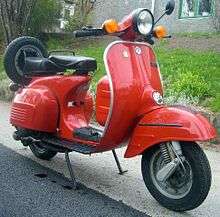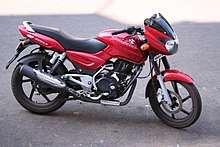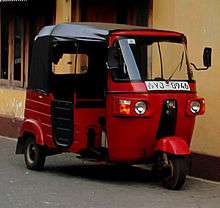Bajaj Auto
 | |
| Public | |
| Traded as | |
| Industry | Automotive |
| Founded | November 29, 1945 |
| Founder | Jamnalal Bajaj |
| Headquarters | Pune, India |
Key people | |
| Products | Motorcycles, three-wheeler vehicles and cars |
| Revenue |
|
| ₹35.6254 billion (US$500 million) (2015–16) | |
Number of employees | 9,119 (March 2014)[2] |
| Parent | Bajaj Group |
| Website |
www |
Bajaj Auto Limited is a global two-wheeler and three-wheeler Indian manufacturing company.[3] It manufactures and sells motorcycles, scooters and auto rickshaws. Bajaj Auto is a part of the Bajaj Group. It was founded by Jamnalal Bajaj in Rajasthan in the 1940s. It is based in Pune, Mumbai, with plants in Chakan (Pune), Waluj (near Aurangabad) and Pantnagar in Uttarakhand.[4] The oldest plant at Akurdi (Pune) now houses the R&D centre 'Ahead'.
Bajaj Auto is the world's sixth-largest manufacturer of motorcycles and the second-largest in India.[5] It is the world's largest three-wheeler manufacturer.[6]
On May 2015, its market capitalisation was ₹640 billion (US$8.9 billion), making it India's 23rd largest publicly traded company by market value.[7] The Forbes Global 2000 list for the year 2012 ranked Bajaj Auto at 1,416.[4]
History

Bajaj Auto came into existence on 29 November 1944 as M/s Bachraj Trading Corporation Private Limited.[8] It started off by selling imported two- and three-wheelers in India.[8] In 1959, it obtained a license from the Government of India to manufacture two-wheelers and three-wheelers[8] and obtained Licence from Piaggio to manufacture Vespa Brand Scooters in India and started making Vespa 150 scooters. It became a public limited company in 1960.[9] In 1970, it rolled out its 100,000th vehicle.[9] In 1977, it sold 100,000 vehicles in a financial year.[9] In 1985, it started producing at Waluj near Aurangabad.[9] In 1986, it sold 500,000 vehicles in a financial year.[9] In 1995, it rolled out its ten millionth vehicle and produced and sold one million vehicles in a year.[10]
With the launch of motorcycles in 1986, the company has changed its image from a scooter manufacturer to a two-wheeler manufacturer.
In 2017 it was announced that Bajaj Auto and Triumph Motorcycles Ltd would form an alliance to build mid-capacity motorcycles[11].
According to the authors of Globality: Competing with Everyone from Everywhere for Everything, Bajaj has operations in 50 countries creating a line of bikes targeted to the preferences of entry-level buyers.[12]
Current products


Bajaj manufactures and sells motorcycles, scooters, auto-rickshaws and most recently, cars. Bajaj Auto is India's largest exporter of motorcycles and three-wheelers.[1] Bajaj Auto's exports accounted for approx. 35% of its total sales. 47% of its exports are made to Africa. Boxer motorcycle is the largest selling single brand in Africa.
Motorcycles manufactured by Bajaj Auto Company
Bajaj is the first Indian two-wheeler manufacturer to deliver 4-stroke commuter motorcycles with sporty performance for the Indian market, which was otherwise dominated mostly by mileage-based products from Hero Honda and TVS Motors. Bajaj achieved this with the 150cc and 180cc Pulsar, giving Indians the first taste of performance biking. This was also accompanied by innovative marketing techniques - by featuring its flagship product Pulsar 220 DTS-i in Pulsar MTV Stuntmania, India's first stunt biking reality show
Motorcycles in production include the Platina, Discover, Pulsar, Avenger, Dominar and CT 100. In FY 2012-13, it sold approximately 3.76 million motorcycles which accounted for 31% of the market share in India. Of these, approximately 2.46 million motorcycles (66%) were sold in India and remaining 34% were exported.
Three wheeler
It is the world's largest manufacturer of 3-wheelers and accounts for almost 84% of India's three-wheeler exports. During the FY 2012-13, it sold approx. 480,000 three-wheelers which was 57% of the total market share in India. Out of these 480,000 three-wheelers, 53% were exported and remaining 47% were sold in India.
Low cost cars
In 2010, Bajaj Auto announced cooperation with Renault and Nissan Motor to develop a US$2,500 car, aiming at a fuel efficiency of 30 kilometres per litre (85 mpg‑imp; 71 mpg‑US) (3.3 L/100 km), or twice an average small car, and carbon dioxide emissions of 100 g/km.[13][14]
On 3 January 2012, Bajaj auto unveiled the Bajaj RE60, a mini car for intra-city urban transportation. The target customer group will be Bajaj's three-wheeler customers.[15] According to its Managing Director Rajiv Bajaj, the RE60 powered by a new 200 cc rear mounted petrol engine will have a top speed of 70 kilometres per hour (43 mph), a mileage of 35 kilometres per litre (99 mpg‑imp; 82 mpg‑US) and carbon dioxide emissions of 60 g/km.[15][16]
Acquisitions
Bajaj Auto bought a controlling stake in the Tempo Firodia company, renaming it "Bajaj Tempo". Germany's Daimler-Benz, a long-time collaborator with Firodia because of their ownership of the original Tempo works in Germany, owned 16% of Bajaj Tempo. Daimler sold their stake back to the Firodia group in 2001, meaning that they once again held a controlling interest, with BAL retaining 24% of the shares. It was agreed that Bajaj Tempo would gradually phase out the use of the "Tempo" brand name, as it still belonged to Mercedes-Benz.[17] The name of the company was changed to Force Motors in May 2005, dropping "Bajaj" as well as "Tempo", over the objections of Bajaj Auto with whom the company shares a long history as well as a compound wall.[18]
Bajaj-Kawasaki end tie-up in 2017
Bajaj and Kawasaki have ended their 33-year alliance in India following deepening of ties between the former and its Austrian partner KTM. Bajaj Auto had an alliance with Kawasaki for the sale and after sales service of Kawasaki motorcycles through its Probiking, a premium bike dealership network, since 2009. These Probiking dealerships were later converted to KTM dealerships.
Bajaj Auto Ltd. made a technical assistance agreement with Kawasaki Japan in 1984, and since then it had cooperated to expand production and sales of motorcycles in India.[19]
Demerger in 2008
The demerger of Bajaj Auto Ltd into three corporate entities—Bajaj Finserv Ltd (BFL), Bajaj Auto Ltd (BAL), and Bajaj Holdings and Investment Ltd (BHIL)—was completed with the shares listing on 26 May 2008.[20][21]
Listing and shareholding
Listing
Bajaj Auto's equity shares are listed on Bombay Stock Exchange where it is a constituent of the BSE SENSEX index,[22] and the National Stock Exchange of India where it is a constituent of the CNX Nifty.[23]
Shareholding
On 30 Sep 2015, 49.29% of the equity shares of the company were owned by the promoters Bajaj Group and the remaining were owned by others.
| Shareholders (as on 30-Sep-2015) | Shareholding % |
|---|---|
| Promoters: Bajaj Group | 49.29% |
| Mutual funds, FIs and insurance companies | 08.13% |
| Foreign institutional investors | 14.25% |
| Individual shareholders | 15.12% |
| Bodies corporate | 08.25% |
| Foreign portfolio investments corporations | 03.51% |
| GDRs | 00.02% |
| Others | 01.43% |
| Total | 100.0% |
Employees
Bajaj Auto had a total of 8,036 employees as of 31 March 2013, of which 51 were women (0.63%) and 25 were differently-abled (0.31%).[25] It spent ₹6.5 billion (US$91 million) on employee benefit expenses during the FY 2012–13. The company is headed by Rahul Bajaj, whose net worth was around US$2 billion in March 2013.[26]
Awards and recognitions
- Bajaj Pulsar 135 LS received Bike of the Year 2010 award from BBC - TopGear and Bike India.[27]
- Pulsar 220 DTS-Fi received the Bike of the Year 2008 award by all major Indian automobile magazines like Overdrive, AutoCar, Business Standard Motoring and Bike Top Gear.[28]
- In 2006, Bajaj Auto won the Frost & Sullivan Super Platinum Award for manufacturing excellence in its Chakan Plant.[29]
- It received award for The Most Customer Responsive Company in Automobiles category in a survey conducted by Economic Times for the years 2004, 2006 and 2008.[30]
- Bajaj Auto received the Bike Maker of the Year award in ICICI Bank Overdrive Awards 2004.[31]
- Bajaj Pulsar 180 DTS-i won the BBC World Wheels Viewers Choice Two Wheeler of the Year 2003 award.[32]
See also
References
- 1 2 "Bajaj Auto Quarterly Results". Retrieved 23 July 2016.
- ↑ "Archived copy" (PDF). Archived from the original (PDF) on 12 April 2015. Retrieved 2015-07-03.
- ↑ "Company Profile - Bajaj Auto". Equitylion. Retrieved 20 June 2017.
- 1 2 "Bajaj Auto at Forbes". Forbes. 31 May 2013. Retrieved 27 October 2013.
- ↑ "News Article". Reuters. 17 May 2012. Retrieved 22 May 2012.
- ↑ "India is the largest three-wheeler industry globally". Deccan Chronicle. 15 March 2016. Retrieved 15 December 2016.
The top-three players such as market leader Bajaj Auto, second largest manufacturer Piaggio and Mahindra and Mahindra […].
- ↑ "Table 4-12: Top '50' Companies by Market Capitalisation as on March 31, 2013". NSE India. 31 March 2013. Retrieved 27 October 2013.
- 1 2 3 "Achievements 1945-1959". Bajaj Auto. Archived from the original on 29 October 2013. Retrieved 27 October 2013.
- 1 2 3 4 5 "Achievements 1960-1991". Bajaj Auto. Archived from the original on 29 October 2013. Retrieved 27 October 2013.
- ↑ "Achievements 1992-2009". Bajaj Auto. Archived from the original on 17 October 2013. Retrieved 27 October 2013.
- ↑ http://www.business-standard.com/article/companies/bikes-from-bajaj-tie-up-will-be-sold-here-exported-too-nick-bloor-117081700070_1.html/
- ↑ Sirkin, Harold L; James W. Hemerling, and Arindam K. Bhattacharya (11 June 2008). GLOBALITY: Competing with Everyone from Everywhere for Everything. Archived 23 September 2008 at the Wayback Machine. New York: Business Plus, 304. ISBN 0-446-17829-2.
- ↑ "How green is my low-cost car? India revs up debate". ENN. 19 June 2008. Retrieved 24 November 2010.
- ↑ "Bajaj small car may cost Rs 1.1 lakh – News – Zigwheels". Timesofindia.zigwheels.com. Archived from the original on 30 May 2010. Retrieved 24 November 2010.
- 1 2 "Bajaj Auto unveils small car RE 60 in partnership with Nissan and Renault". The Times of India. 3 January 2012. Retrieved 3 January 2012.
- ↑ Saxen, Ruchita (3 January 2012). "Bajaj Auto launches low cost car RE 60, promises 40 km per litre". New Delhi Television. Retrieved 3 January 2012.
- ↑ "Bajaj Tempo will now be Force Motors". The Times of India. Bennett, Coleman & Co. Ltd. 24 February 2005. Retrieved 20 September 2013.
- ↑ "Bajaj Tempo will now be Force Motors". The Times of India. TNN. 24 Feb 2005. Retrieved 18 June 2018.
- ↑ Iyer, Satyanarayan (25 March 2017). "Bajaj Auto ends its partnership with Kawasaki in India". Times of India.
- ↑ "Bajaj Auto demerger complete". The Economic Times. 25 May 2008. Retrieved 21 May 2009.
- ↑ "Demerger News". Bajaj Auto. Archived from the original on 22 October 2013. Retrieved 27 October 2013.
- ↑ "Scripwise Weightages in S&P BSE SENSEX". BSE India. Retrieved 27 October 2013.
- ↑ "Download List of CNX Nifty stocks (.csv)". NSE India. Retrieved 27 October 2013.
- ↑ "Shareholding Pattern".
- ↑ "Business Responsibility Report 2012-13" (PDF). Bajaj Auto. Archived from the original (PDF) on 29 October 2013. Retrieved 27 October 2013.
- ↑ "Rahul Bajaj at Forbes". Forbes. Retrieved 27 October 2013.
- ↑ "Awards and accolades 2010-2011". Bajaj Auto. Archived from the original on 29 October 2013. Retrieved 27 October 2013.
- ↑ "Awards and accolades 2007-2008". Bajaj Auto. Archived from the original on 29 October 2013. Retrieved 27 October 2013.
- ↑ "Bajaj Auto wins TPM Excellence Award 2006". MoneyControl.com. 7 February 2007. Retrieved 27 October 2013.
- ↑ "Awards and accolades 2005-2006". Bajaj Auto. Archived from the original on 29 October 2013. Retrieved 27 October 2013.
- ↑ "Awards and accolades 2003-2004". Bajaj Auto. Archived from the original on 29 October 2013. Retrieved 27 October 2013.
- ↑ "Awards and accolades 2002-2003". Bajaj Auto. Archived from the original on 29 October 2013. Retrieved 27 October 2013.
External links
| Wikimedia Commons has media related to Bajaj Group. |
- Business data for Bajaj Auto:
- Reuters